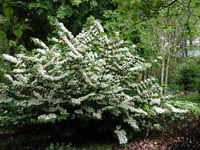Resource Library
Plant of the Week: Viburnum, Shasta (Double Viburnum)
The University of Arkansas System Division of Agriculture does not promote, support or recommend plants featured in "Plant of the Week." Please consult your local Extension office for plants suitable for your region.
Plant of the Week
Shasta Viburnum, Double Viburnum
Latin: Viburnum plicatum var. tomentosum

For a plant to catch your attention in the over abundance of spring, it has to be special. Shasta viburnum is one of the spring bloomers that not only catches your interest in spring, but holds it the rest of the year.
Shasta viburnum (Viburnum plicatum var. tomentosum) is a large deciduous shrub with a rectangular profile, usually wider than tall. While size estimates vary, I’ve seen a number that are 12 feet high and 15 feet wide after 15 years. It produces an upright trunk - oftentimes several trunks - that produce parallel, horizontal branches spaced about a foot apart. These tiered, evenly spaced branches give Shasta a distinctive wintertime appearance.
The 5-inch long ovate leaves are bright green with a corrugated surface. When grown in a sunny location the leaves take on a dull, purplish-red fall color.
Shasta is one of the "doublefile" viburnums, a name given to the group because blooms are produced in large, flat-topped inflorescences down each side of these layered side branches. The showy white bloom clusters are 5 or 6 inches across and composed of an outer rim of flowers to 1 and 1/2 inches across.
Smaller, fertile, star-like white florets dominate the center of the inflorescence, but a number of the larger, sterile flowers are scattered amongst these. When in full flower, the emerging leaves are almost obscured by a cloud of white. Blooms appear in late April or early May in north Arkansas.
As beautiful as the flowers are, I’ve had more comment from garden visitors on the stunning berries that appear in mid June. The red, turning to black, berries are held upright above the layered branches and produce a spectacular effect. The birds love them.
Shasta viburnum is a release from the U.S. National Arboretum, having been developed by Dr. Donald Egolf (1928 - 1990). Egolf began his shrub breeding work for the arboretum in 1958 and introduced almost 60 ornamentals (including a dozen viburnums) to the nursery trade, many of which have become the standard items against which all others are judged.
Shasta viburnum actually had its beginning during his graduate school days at Cornell University. In 1954, he crossed an unnamed seedling doublefile viburnum with ‘Mariesii,’ an old, still popular cultivar developed by the James Veitch & Sons Nursery in Chelsea, England. From this population, he selected individuals with strong horizontal branching habit and large flowers. These were allowed to intermingle. The best seedling was selected from the F2 population in 1968, which Shasta officially released in 1979.
Egolf is one of several prominent horticulturists to have his career tragically cut short in auto accident. Perhaps there is some credence to the observation that we tend towards being bad drivers, always scanning the scene for plants and not paying enough attention to the road.
So, after 50 years of work, Shasta has become fairly common in the springtime landscape of much of the country. I have heard it suggested that viburnums can be used as a substitute for dogwoods, a suggestion I dismissed as wishful thinking. But, Shasta viburnum is as showy as most dogwoods in bloom, so they could serve in that capacity.
Shastas are easy to find in nurseries and easy to grow. They tolerate a wide array of soil types, but do best in better soils. Mine receive a bit of direct sun in the morning beneath the oaks and bloom heavily each spring, but there is little fall color in the shady site. In sunnier sites, they will be more compact and broad spreading.
As a rule, viburnum seeds are difficult to germinate. But, that does not seem to be the case with Shasta, for a number of seedlings have appeared beneath my plants. I see no indication of spread beyond the immediate vicinity of the bush, but birds do fly.
By: Gerald Klingaman, retired
Extension Horticulturist - Ornamentals
Extension News - May 6, 2005
The University of Arkansas System Division of Agriculture does not maintain lists of retail outlets where these plants can be purchased. Please check your local nursery or other retail outlets to ask about the availability of these plants for your growing area.